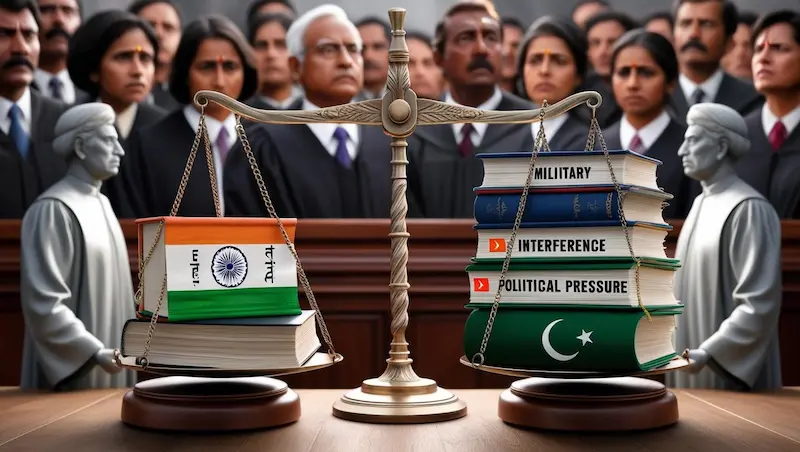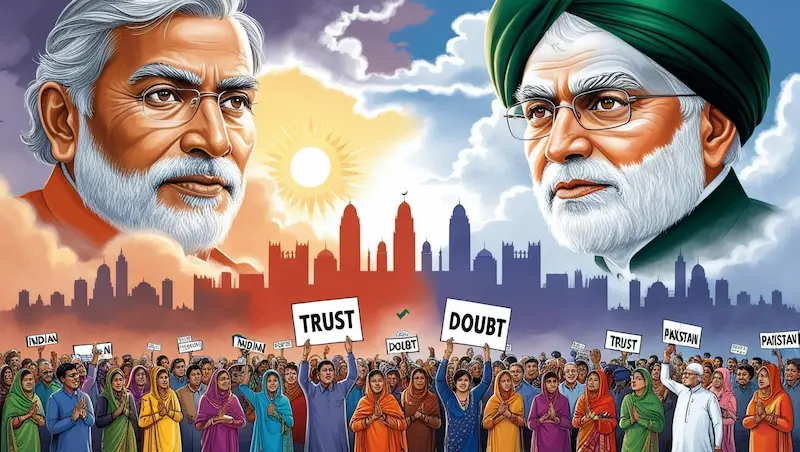In a world where justice can be a mirage and power often bends the scales, two of South Asia’s most powerful courts are under the microscope. One is celebrated for bold reforms; the other for fearless verdicts—yet both face piercing questions about their integrity.

When the stakes are national stability and the lives of millions, how does a country’s highest court measure up? The Supreme Courts of India and Pakistan have long stood as towering institutions in their respective democracies, often stepping into the political arena to defend—or, at times, reshape—the constitutional order. But which of these apex courts holds more power? Which one upholds justice more righteously? And most importantly, which one has earned the trust of its people?
Drawing from in-depth analysis and data gathered via Grok, we dive into a side-by-side comparison of these judicial giants on three decisive fronts: power, impartiality, and righteousness.
The Battle of Powers: A Tale of Two Constitutions
India’s Supreme Court operates with a constitutional arsenal unmatched by most judicial bodies worldwide. Armed with judicial review under the Kesavananda Bharati case, it can strike down even constitutional amendments that threaten the basic structure of the Constitution. Through Public Interest Litigation (PIL), it becomes the voice of the voiceless, influencing everything from environmental policy to gender rights.
Pakistan’s top court, while also constitutionally empowered, carries the scars of military overreach and political interference. Its suo motu powers once gave it tremendous clout—famously demonstrated in the disqualification of Prime Minister Nawaz Sharif in the Panama Papers case. But with the 26th Amendment (2024) clipping the Chief Justice’s powers and tightening executive control over appointments, the court’s wings are being methodically clipped.
Verdict: India’s Supreme Court is the undisputed heavyweight in terms of judicial reach and policy impact.

Impartiality: Between Shadows and Spotlights
India’s judicial system is propped up by a collegium system designed to resist executive overreach. Despite recent criticisms—like delayed hearings on Article 370 or perceived passivity on mob lynching cases—it retains significant public trust.
Across the border, Pakistan’s judiciary has a more turbulent history. While the court has risen in moments of moral clarity, such as restoring Chief Justice Iftikhar Chaudhry in 2007 or challenging patriarchal norms in 2025, it also carries the burden of legitimizing military coups and making controversial political judgments.
Verdict: While neither court is free from bias, India’s bench benefits from stronger democratic scaffolding, making it relatively more impartial.
Righteousness: Whose Conscience Rings Louder?
Righteousness may be subjective, but landmark decisions often become moral lighthouses. India’s Supreme Court has consistently leaned into progressive rulings—from decriminalizing homosexuality in Navtej Singh Johar (2018) to upholding privacy in Puttaswamy (2017). It also influences global jurisprudence, with its rulings often cited abroad, including in Pakistan.
Pakistan’s court, to its credit, has fought for human rights and equality in recent years. Its embrace of Indian precedents on gender equality and its actions against discriminatory practices show signs of ethical evolution. Yet its legacy remains stained by past concessions to autocracy and recent amendments seen as judicial backsliding.
Verdict: India’s court emerges as more righteous overall, though its own inconsistencies, especially on sedition laws and political silence, keep it from sainthood.

Conclusion
While both supreme courts walk a tightrope between law and politics, India’s Supreme Court stands taller—with broader powers, stronger institutional independence, and a longer list of rights-affirming verdicts. Pakistan’s judiciary, though brave in spurts, continues to grapple with its complex legacy of political entanglement and military shadows.
But here’s the real takeaway: judicial power isn’t just about verdicts—it’s about who trusts the court when it matters most.
As political winds shift and democratic backsliding looms large in parts of South Asia, the ultimate test for both courts is not just in their rulings—but in how firmly they hold the constitutional line when democracy itself is on trial.
EditorSpeak
India shouldn’t set its sights on just outdoing Pakistan—it should aim higher, striving to be the best version of itself. That means real, meaningful reforms in the judiciary, not just in how we vote. But let’s be honest: who’s going to take the first step? Are our politicians really going to pass laws that limit their own ability to divide us—whether by religion, region, race, or income? And what about the judges? Will they be willing to put their careers, even their personal safety, on the line to truly uphold the rule of law? The real test is whether today’s leaders—on the bench and in parliament—are ready to set an example for the next generation. Between the two countries, India’s courts have a stronger shot at leading the way. But if change is going to happen, it has to start now. Let’s go, Supreme Court—it’s time to stand with the people, not just the wealthy, the bureaucrats, or the political elite. The country is counting on you to put ordinary citizens first.



